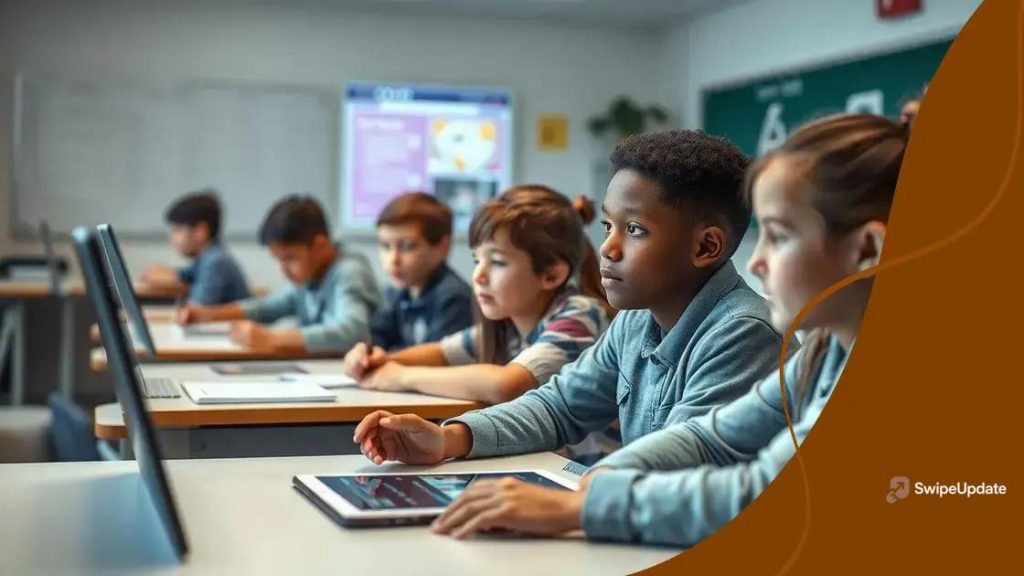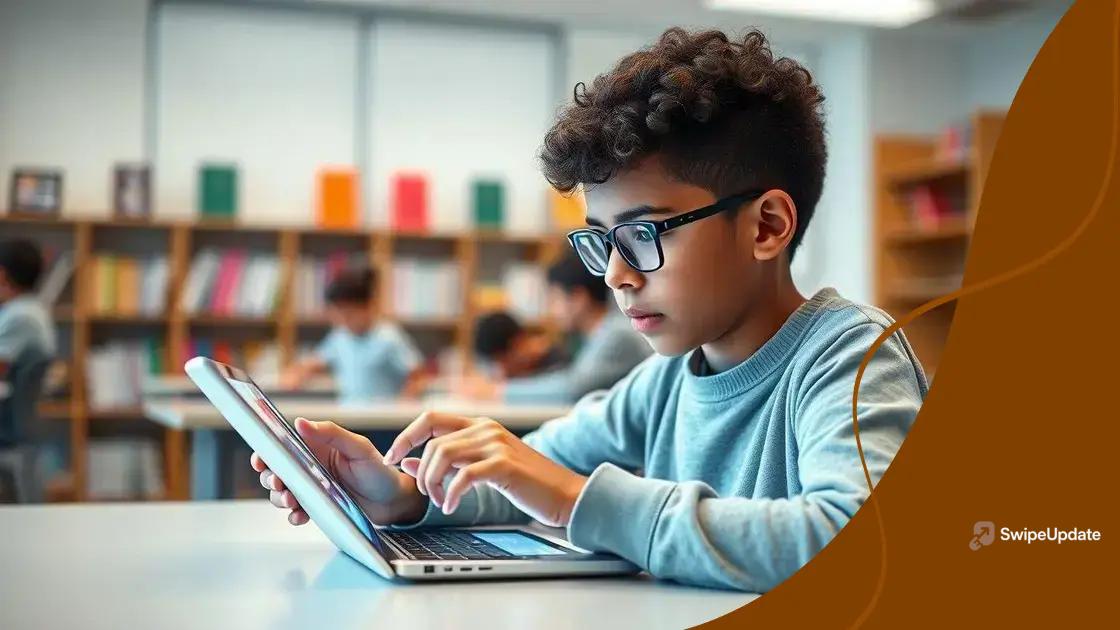The part artificial intelligence plays in education

The part artificial intelligence plays in education includes personalizing learning, enhancing teacher support, integrating virtual reality for immersive experiences, and improving collaboration, all while addressing challenges like data privacy and infrastructure.
The part artificial intelligence plays in education is more significant than many realize. It influences how students learn and engage, offering tailored experiences that could reshape the classroom. Have you wondered how this technology might change learning for the better?
Understanding the role of artificial intelligence in education
Understanding the role of artificial intelligence in education is essential as it reshapes how both teachers and students experience learning. AI technologies can enhance educational methods, making them more engaging and efficient.
AI Enhancing Teaching
Teachers greatly benefit from AI systems. These tools assist in grading, providing feedback, and identifying students’ strengths and weaknesses. This way, educators can focus on personalized instruction rather than administrative tasks.
Personalized Learning Experiences
AI helps create a personalized learning environment for every student. By analyzing data, AI systems can suggest resources tailored to individual needs and learning styles. This adaptability can lead to better academic performance.
- Real-time feedback for immediate improvement
- Customized exercise and assignment recommendations
- Adaptive testing to assess students’ knowledge
Additionally, artificial intelligence fosters collaboration among students, making learning more interactive. Students can engage with virtual tutors or peer-to-peer learning platforms powered by AI.
Improving Accessibility
AI tools have made education more accessible, especially for those with learning disabilities. Programs that convert text to speech or offer predictive text assistance can help all students participate equally.
As we explore how AI impacts education, it’s crucial to consider its potential to change traditional methods of learning. With ongoing advancements, the classroom experience stands to improve significantly. Teachers can leverage these tools to create a more engaging and responsive learning atmosphere.
Benefits of AI for students and teachers
The benefits of AI for students and teachers are transforming education. Both groups gain from technology that enhances learning and teaching experiences. From personalized lesson plans to quick grading, AI is making a significant impact.
Personalized Learning for Students
Students can enjoy tailored learning experiences that fit their individual needs. AI systems analyze data to adapt to each student’s learning style. This personalization helps students grasp difficult concepts.
- Custom learning paths that evolve with progress
- Immediate feedback to improve understanding
- Access to additional resources based on performance
Furthermore, AI tools enable students to work at their own pace. This flexibility can lead to higher motivation and better outcomes. Each learner can receive the appropriate challenges to keep them engaged.
Support for Teachers
Teachers also benefit from AI by gaining support in their daily tasks. With AI tools performing administrative tasks, teachers can focus more on creating engaging lessons. For example, AI can provide grading assistance and analyze student performance efficiently.
This powerful technology allows teachers to identify which students may need extra help. By using AI to monitor progress, educators can adjust their teaching strategies accordingly. They gain insights into classroom dynamics and can address issues proactively.
Moreover, AI fosters collaboration among educators through shared resources and best practices. Teachers can use AI platforms to exchange strategies and lesson plans that work. This sense of community enhances overall teaching effectiveness.
How AI can personalize learning experiences

AI can significantly enhance how students learn by personalizing their educational experiences. Through data analysis, artificial intelligence can tailor content to fit the unique needs of each individual. This method ensures that every student receives the support necessary to thrive.
Adaptive Learning Systems
One of the key features of AI in education is adaptive learning. These systems adjust the difficulty of tasks based on student performance. When a student struggles with a concept, the AI can provide easier problems or additional resources.
- Real-time assessments that modify lessons
- Immediate feedback on tasks to guide learning
- Customized study plans that evolve as skills improve
This creates a more engaging learning environment, allowing students to take charge of their progress. They feel more motivated when lessons are tailored to their abilities.
Smart Content Recommendations
AI can recommend resources tailored to a student’s interests and learning style. For example, if a student enjoys hands-on activities, the AI might suggest interactive games or projects that reinforce learning.
These recommendations help keep students engaged and excited about their education. By providing a variety of resources, including videos and quizzes, AI encourages exploration and discovery. It creates a dynamic learning journey that adapts to each student’s preferences.
In addition, AI collects data on learning habits over time. This information can help educators understand what works best for each student and adjust their teaching methods accordingly. With AI’s support, education can become more effective and enjoyable.
Challenges in integrating AI into educational systems
Integrating AI into educational systems presents several challenges that schools and institutions must navigate. While the benefits of AI are vast, understanding the difficulties is equally important. Addressing these challenges ensures that AI can enhance education effectively.
Infrastructure and Resources
One major hurdle is the need for robust technology infrastructure. Many schools lack the necessary hardware and software to support AI applications. Insufficient internet access can also hinder the implementation of AI tools.
- Inconsistent access to high-speed internet
- Outdated hardware that cannot run advanced AI software
- Lack of training for teachers on new technologies
When schools do not have reliable technology, it can lead to unequal learning opportunities. Students in well-funded districts may excel, while those in under-resourced areas could fall behind.
Data Privacy Concerns
Another challenge lies in data privacy and security. AI systems require access to student data to provide personalized learning experiences. However, this raises concerns over how that data is collected, stored, and used.
Parents and educators may worry about the potential misuse of sensitive information. Ensuring that data is protected is crucial for building trust among stakeholders.
Moreover, regulations on data usage can complicate the integration process. Schools must navigate compliance with laws like FERPA and COPPA, which govern how student information is handled.
Ultimately, while the challenges of integrating AI into educational systems are significant, addressing them head-on can lead to innovative solutions that benefit everyone involved in the educational process.
Future trends of AI in education
The future trends of AI in education are exciting and full of possibilities. As technology advances, we can expect significant changes that will enhance learning experiences for students and teachers alike.
Increased Personalization
One major trend is the continued expansion of personalized learning. AI systems will become even more sophisticated at analyzing student data to provide custom learning experiences. This will allow educators to create tailored lesson plans that align with each student’s strengths and interests.
- Enhanced algorithms for better data analysis
- More intuitive tutoring systems
- Dynamic learning pathways that adapt in real time
As these systems evolve, students will receive a more engaging and effective education, catering to their specific needs.
Integration of Virtual Reality
Another promising trend is the integration of virtual reality (VR) with AI. Combining these technologies can create immersive learning environments where students can explore complex concepts through hands-on experiences.
For instance, science students could conduct virtual experiments, while history students might take part in interactive historical events. This innovative approach can increase student engagement and retention of knowledge.
As AI helps develop these VR experiences, education will become more interactive and accessible, making learning enjoyable and memorable.
Enhanced Collaboration Tools
Collaboration tools powered by AI will also play a pivotal role in the future of education. These tools can facilitate communication among students, teachers, and parents, enabling a community approach to learning.
AI-driven platforms can help identify students who need assistance or encourage collaboration on group projects. This fosters teamwork, critical thinking, and problem-solving skills.
Ultimately, as AI continues to shape education, the possibilities are endless. We will likely see improvements in student engagement, personalized learning, and collaboration, leading to a richer educational experience for all.
The integration of artificial intelligence into education is paving the way for a more personalized and engaging learning experience. As we look to the future, the trends highlight the potential for increased personalization, immersive virtual reality experiences, and improved collaboration tools. These advancements aim to create an inclusive environment where every student can thrive. While there are challenges to address, such as infrastructure and data security, the possibilities are limitless. Embracing AI in education promises to revolutionize how we teach and learn, making education more effective and accessible for everyone.
FAQ – Questions Frequently Asked About AI in Education
How does AI personalize learning experiences for students?
AI analyzes student data to provide tailored learning paths, ensuring that each student receives support based on their unique strengths and weaknesses.
What are the benefits of integrating virtual reality in classrooms?
Virtual reality allows students to engage in immersive experiences, enhancing understanding by allowing them to explore concepts in an interactive environment.
How can collaboration tools powered by AI improve communication?
AI-driven collaboration tools facilitate better communication among students, teachers, and parents, promoting a community approach to education and teamwork.
What challenges do schools face when adopting AI technologies?
Schools may struggle with infrastructure issues, data privacy concerns, and the need for teacher training to effectively utilize AI systems in the classroom.
